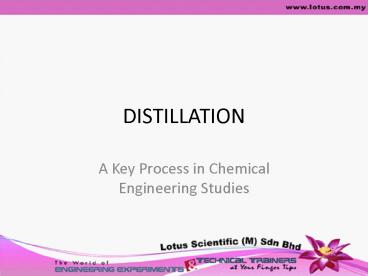DISTILLATION - PowerPoint PPT Presentation
1 / 16
Title: DISTILLATION
1
DISTILLATION
- A Key Process in Chemical Engineering Studies
2
INTRODUCTION
- Distillation is the separation process of fluid
mixtures - The mixture can either be liquid-liquid,
liquid-gas, or gas-gas - The mixture can contain 2 or more components with
varying boiling points - The component with the higher boiling point is
called the more volatile component (MVC) - There are 2 basic methods of distillation
3
FLASH DISTILLATION
- Flash distillation works by boiling a mixture to
vaporize the lower boiling point component - Then component is then condensed without any
liquid returning to the system - The system has no reflux (all the condensate is
drawn off as product)
4
FLASH DISTILLATION
5
FLASH DISTILLATION
- Advantages
- The process is fast and low-cost
- Can be run in batches or continuously
- Disadvantages
- Only effective for components with large
difference in boiling points - Not so useful for equally volatile components
6
DISTILLATION WITH REFLUX
- Also known as rectification
- A part of the condensate is returned to the
distillation column - The returning liquid comes into close contact
with the vapor - The returning of liquid is termed reflux
7
DISTILLATION WITH REFLUX
- Advantages
- Able to separate components with similar boiling
points - Can achieve high separation
- Disadvantages
- The process is slower
- The system is usually more expensive
8
Distillation Column Types
- Packed Column rings, balls, saddles, etc.
- Sieve tray/plate
- Bubble cap
- Main objective to increase efficiency
9
VAPOR-LIQUID EQUILIBRIUM (VLE)
- When a mixture is boiled, the components have
different liquid and vapor compositions - The compositions are determined by the
temperature and pressure - An equilibrium curve can be plotted for
compositions at specific temperatures and
pressures
10
VAPOR-LIQUID EQUILIBRIUM (VLE)
11
VAPOR-LIQUID EQUILIBRIUM (VLE)
- This curve is important because it is used to
- determine the phase compositions of a component
at a particular temperature/pressure - determine the maximum achievable separation
- estimate the number of plates needed in a
continuous distillation column with reflux
12
BOILING-POINT DIAGRAM
- A diagram similar to the VLE curve is the boiling
point diagram - It relates the liquid and vapor phase
compositions to temperature
13
BOILING-POINT DIAGRAM
14
RECTIFICATION AND STRIPPING
- Rectification is simply continuous distillation
with reflux - When a mixture is fed to center of a column, the
rising vapor strips it of the MVC, leaving the
less volatile component to flow down - When combined, a highly pure top and bottom
product can be obtained
15
(No Transcript)
16
DISTILLATION IN THE INDUSTRY
- Petroleum refineries use multi-stage continuous
distillation to separate crude oil - Ethanol is distilled from fermented carbohydrates
such as rice, corn, wheat, barley etc. - Air is distilled to obtain argon, a useful inert
gases and liquid nitrogen































